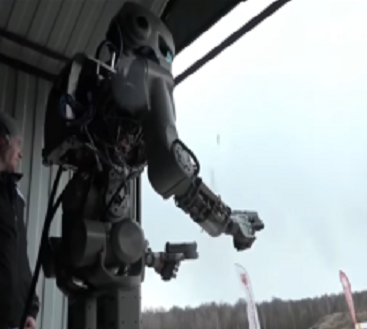By Jon Gabay, contributing writer
Recently, news stories have been surfacing about the Russians teaching their AI robots to shoot handguns. As AI and robotics advance, it seems that there have been enough warnings from people around the world. “Don’t give AI machines weapons.” But do we listen? No.
Named FEDOR, which is an acronym for Final Experimental Demonstration Object Research, one Russian robot has already demonstrated its ability to drive a car and is dexterous enough to screw in a light bulb. Developed by a Russian company called Android Technics, its charter is to develop anthropomorphic robots and AI-based robot control systems.
The Russians insist that teaching the terminator-like robot how to shoot two handguns simultaneously while performing target acquisition and performing friend-or-foe analysis is just to improve the eye and hand coordination.

Teaching an AI robot how to shoot with both hands at multiple targets is an engineering accomplishment. But is it a benefit to society? Image source: YouTube.
The way the robot's developers see it, shooting things can be a good way to test the decision-making and coordination of a learned motor skill (no pun intended). In response to all the buzz surrounding the intelligent robot, Russian Deputy Prime Minister, Dmitry Rogozin, tweeted: “We are not creating a Terminator, but artificial intelligence that will be of great practical significance in various fields.”
But the military is already using robotic weapons and applying AI. In a video released by Rogozin, you can not only see FEDOR shooting away at several targets, but you can also see a robotic tank doing autonomous targeting and destruction of targets. And the Russians are not alone. U.S. drones and the next generation of brilliant weapons will be using AI to make in-the-field, real-time decisions as to friend or foe, s well as who to kill and who to spare. And it’s not just soldiers’ jobs at risk.
Robotics and artificial intelligence are both improving at an accelerating rate and have been for several reasons, but a key one is to reduce or eliminate the need for the worker entirely. Dangerous occupations will be the first area to justify societal acceptance. While it’s true that sending humans into danger has been OK for the military, it is not true for the civilian worker. That’s why workers who deal with hazardous materials and workplace environments are typically better-paid than workers who work in safe, clean, and non-toxic places.
Not sending a person to disarm a bomb that can be disarmed through a robotic avatar with clear vision, communications, and dexterity can save lives. The same is true when sending in a robot to clean up a nuclear spill inside a highly radioactive nuclear reactor. As a matter of fact, the same company that makes FEDOR is also making a robot in conjunction with Toshiba to clean up Fukishima. Such robots may be expensive, but workers cost more money in the end.
Of course, the Russian news stories about teaching robots how to shoot weapons can evoke mixed emotions. From a technological point of view, it’s fascinating to watch a machine learn, understand, and refine its movements to learn how to shoot at targets and improve.
On the other hand, we all know where this technology is leading: to the military, to law enforcement, and maybe even one day, to autonomous rule.
There’s a good quote that goes, “The young don’t always do what they are told.” And while we want to think of the human species as smart, advanced, and mighty, we have some work to do. We’re still unraveling the basics of the universe and haven’t even mastered how to properly treat each other, creatures, and planets. I hope AI beings learn faster and better.
Since studying electrical engineering, Jon Gabay has worked with defense, commercial, industrial, consumer, energy, and medical companies as a design engineer, firmware coder, system designer, research scientist, and product developer. As an alternative energy researcher and inventor, he has been involved with automation technology since he founded and ran Dedicated Devices Corp up until 2004. Since then, he has been doing research and development, writing articles, and developing technologies for next-generation engineers and students.
Advertisement
Learn more about Electronic Products Magazine





